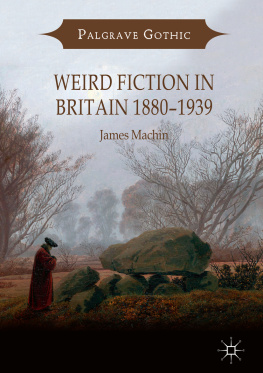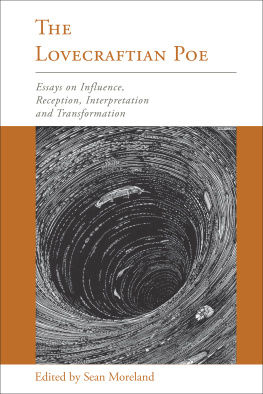S. T. Joshi
Copyright 2016 by S. T. Joshi.
Cover art by Allen Koszowski. Copyright 2016 by Allen Koszowski.
All rights reserved.
I. The Classics
From Gothic to Weird
The recent effloresence of neo-Gothic fictionthe literature of fear, terror, wonder, awe, and the supernaturalis the product of centuries, perhaps millennia, of work by a wide array of artists both celebrated and obscure. It is, after all, in the Epic of Gilgamesh (c. 1700 b.c.e. ) that we find such motifs as the superhero, the quest for eternal life, battles with monsters, and the like. About a millennium later, the Odyssey is rife with creatures of eccentric cast, from the sorceress Circe to Polyphemus the Cyclops to the twin horrors of Scylla and Charybdis. Greek literature and myth regales us with the Gorgon Medusa, the Furies, the harpies; ghosts stalk through the most elevated of Greek tragedies. Dante and Milton drew only partly upon scripture, but more upon their own imaginations, in depicting the terrors of hell and its demons. The ghost in Hamlet and the witches in Macbeth are familiar to all.
We must, however, be careful not to let our zeal for tracing anticipations of contemporary Gothic elements get the better of us. The literature of terror can only be said to have achieved independent existence when it has substantially segregated itself from religion, myth, and folklore, however much it may draw upon these rich storehouses of belief and ritual. In particular, the literature of the supernatural can only be said to have become viable when, in a given culture, there becomes a relatively clear sense of the natural. If ghosts, goblins, and vampires are commonly considered to be components of the everyday scene, the depiction of them in literature cannot be considered supernatural because it would not constitute a defiance of the natural laws that render such entities beyond the bounds of the possible. It is for this reason that, without perhaps being entirely aware of it, literary scholars have rightly declared that Gothicism commenced as an independent literary mode with the publication of Horace Walpoles The Castle of Otranto (1764). For it was only by the middle of the eighteenth century that human knowledge had advanced to the point where it could, with some confidence, be asserted that creatures such as the ghost or the werewolf were definitively outside the limits of nature.
It is often forgotten that this original Gothic movementrunning, roughly, from 1764 to the 1820sdid not get under way at once upon the publication of Walpoles curious little novel. It required the added impetus of German Romanticism to bring to the fore such literary figures as Ann Radcliffe, Matthew Gregory Lewis, Mary Shelley, and Charles Robert Maturin, not to mention a host of lesser talents. This movement shares many similarities with the horror boom of the 1970s and 1980s, in that it was energized by a quite small number of toweringly original writers and a motley crew of crude imitators who sought to capitalize on the sudden popularity of this literary genre; and there is a further similarity in that the Gothic movement could not in any sense be said to be uniform or monolithic, but quickly fragmented into numerous subgenres and offshoots. The element of supernatural terror was by no means dominant, and Ann Radcliffe (perhaps unwisely) rejected the supernatural altogether in her work, opting instead for what has been called the explained supernatural, where supernatural phenomena are suggested but are explained away (oftentimes in a highly unconvincing manner) at the end. Lewis and Maturin shrewdly avoided this deflation of the readers expectations, while Shelleys Frankenstein (1818), by transferring the locus of fear to radical new discoveries in science, could be said to have contributed significantly to the later creation of science fiction.
In a sense, the Gothic novelists were trying to have their cake and eat it too. While depicting the most outlandish incidents in their tales, they placed many of their narratives in the Middle Ages, at a time whenin their estimationignorance and superstition so dominated the populace that the representation of wondrous events in fiction could be thought to constitute a backhanded kind of psychological realism. More relevantly, the supernatural, in those works that featured it, was acknowledged as beyond the bounds of the real, but because it drew upon deep, vestigial instincts centred around the fear of death and the terrors of hell, it commanded a kind of quasi-belief that was the real secret to its success.
In the 1830s Edgar Allan Poe revolutionized the field both by confining the literature of terror exclusively to the short story and by bringing to that literature an entirely new and intense understanding of the psychology of fear. Poes greatest innovation, quite frankly, was his immense literary talent: any one of his best tales packs more of a punch than entire novels by the Gothicists. That initial wave of Gothic literature fell by the wayside very quickly, as Poe, both by precept and by example, championed the short story as the chosen vehicle for conveying terror. His great contemporary Nathaniel Hawthorne was not quite so rigid in confining Gothicism to the short story; indeed, his House of the Seven Gables (1851) might be said to constitute one of the first instances in American literature in which the entire premise of the work is supernaturalthe curse of the dying Matthew Maule on the entire Pyncheon familyalthough his execution of that premise leads more to wistful melancholy than to fear or horror. Fitz-James OBrien and Ambrose Bierce followed Poe more closely, but in England Poes example of concision and intensity took much longer to find favor. If anyone today is capable of wading through Edward Bulwer-Lyttons Gothic novels, especially the immense A Strange Story (1862), they will find that his work is more in the nature of a philosophical tract than an excursion into the supernatural. J. Sheridan Le Fanu restricted the supernatural almost entirely to the short story or novella, while a legion of Victorian ghost story writersMargaret Oliphant, Mrs. J. H. Riddell, Rhoda Broughton, Amelia B. Edwards, and many othersresurrected the ghost story with seemingly endless variations.
It was, however, at this juncturethe late nineteenth centurythat we come upon some towering works of Gothicism that still color the popular imagination. Less than two decades separate the publication of such novels as Robert Louis Stevensons The Strange Case of Dr. Jekyll and Mr. Hyde (1886), Oscar Wildes The Picture of Dorian Gray (1890/1891), Bram Stokers Dracula (1897), and Henry Jamess The Turn of the Screw (1898)the first two constituting imperishable examples of the doppelgnger motif, while the other two remain the canonical treatments of the vampire and the ghost, respectively. It is of some significance that three of these works are short novels at best, adhering to Poes notions of the unity of effect (which he believed possible only in the short story) but expansive enough to incorporate the interplay and development of character that is one of the distinguishing features of the novel. Indeed, one of the several literary failings of Dracula is probably its excessive length, to say nothing of the fact that its putative lead character, Count Dracula, remains offstage for large segments of the work.
What is most notable about this turn-of-the-century period is the degree to which mainstream literary figures chose to engage in Gothicism, either supernatural or non-supernatural, for the length of a tale or novel. A substantial number of the short stories and novellas of Henry James involve ghosts or the suspicion of ghosts, as do the tales of his friend and disciple Edith Wharton; such Americans as F. Marion Crawford ( The Witch of Prague, 1891; Wandering Ghosts, 1911), Robert W. Chambers ( The King in Yellow, 1895), the architect Ralph Adams Cram ( Black Spirits and White, 1895), Sarah Orne Jewett, Gertrude Atherton, and Mary E. Wilkins-Freeman made vital contributions to the literature of terror; such of their British counterparts as Rudyard Kipling, Sir Arthur Conan Doyle, Wilkie Collins, Richard Marsh ( The Beetle, 1897), H. Rider Haggard ( She, 1887), and H. G. Wells did the same. And what do we make of Joseph Conrads Heart of Darkness (1902)? Its concluding utterance by Kurtz, The horror! The horror! has become almost self-parodic, but this novella as a whole fuses the terrors of the external worldsymbolized by the darkness of deepest Africaand the terrors of the human mind as ably as any work in literature.













